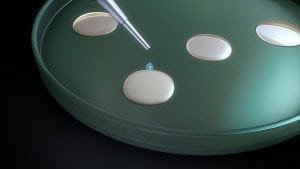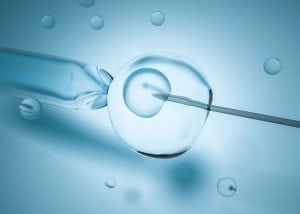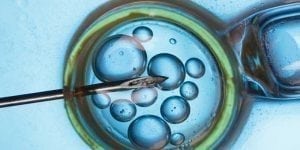Often an egg has been successfully fertilized, but implantation in the uterus still doesn’t occur. For this process to work, certain conditions must be met to increase the success of implantation and overcome implantation difficulties.
What Happens During Implantation?
The fertilization itself takes place in the fallopian tube. Then the fertilized egg cell makes its way to the uterus—a journey that takes about four days, during which the egg cell divides itself every 12 hours. If the egg reaches its destination, the cells divide into an outer and an inner cell layer. The outer cell layer then develops into the placenta and the inner layer develops into the embryo. After about six to nine days, the egg can either successfully implant itself in the uterus, which ideally has formed a thick endometrium or the egg dies and is excreted during the next menstruation. Among other things, which spot the fertilized egg seeks out in the uterus is determined by corresponding attractants. Once implantation has occurred, the hormone HCG is produced, which indicates a positive pregnancy.
Why Implantation Fails

Ectopic Pregnancy
An ectopic pregnancy occurs when the embryo implants itself in the wrong place, namely in the lining of the fallopian tube. This type of pregnancy, which occurs in about one to two percent of all pregnancies, can never be successfully carried out. In some cases, the egg can also implant itself in the ovaries, the cervix or the abdominal cavity. An ectopic pregnancy often ends in miscarriage during the very early stages of pregnancy, but can also continue to grow. Risk factors include previous ectopic pregnancies, endometriosis, tubal inflammation, surgery on the abdomen or pelvis and artificial insemination. Many women never become aware of an ectopic pregnancy, and others do not feel any pain until the embryo has become bigger and causes strong bleeding.
Artificial Insemination and Implantation Problems
Implantation problems often occur with artificial insemination methods such as IVF. Often, successful implantation isn’t possible even after several embryo transfers. There are many reasons why implantation might fail. These include uterine malformations, vascular disorders and immunological responses. Chromosomal abnormalities, unfavorable laboratory conditions, the wrong technique during embryo transfer as well as inadequate sperm quality can also be the cause of implantation failure.
Immunological Rejection
In some cases, the maternal immune system may reject the transferred embryo. The fetal tissue has a different structure and contains different proteins than the tissue of the mother, which is why it may be rejected by the maternal immune system as a foreign body. Normally, antibodies protect the baby in the womb by blocking certain immune cells of the mother. If these so-called FcR-blocking antibodies fail, the mother’s immune system may reject the fetus.
Measures to Support Implantation with IVF
Assisted Hatching
In order for a pregnancy to occur, the embryo must be able to leave its shell (or zona pellucida). However, the embryonic shell is often too thick, which makes implantation difficult. Assisted hatching is a procedure during which the embryonic shell is weakened by creating a small hole with a pipette or laser in order to facilitate the hatching process.
The EmbryoGlue Method
If the embryo has successfully left its shell, implantation in the endometrium must follow. However, sometimes the embryo does not succeed in attaching itself to the uterine lining. A special medium (EmbryoGlue) containing hyaluronan is supposed to increase the likelihood of implantation by acting as an adhesive and facilitating contact between the embryo and the endometrium.
FertiGrow
In order for the embryo to implant itself, the endometrium must offer optimal conditions. U.S. studies have shown that “G-CSF” supports embryo implantation and helps ensure that a pregnancy can be successfully maintained. By applying FertiGrow to the uterus, the endometrium can be enhanced, and the chance of implantation increases.
Implantation Injection and Scratching

Intralipid Infusion
Various studies show that using this method can help improve the implantation rate as well as the live birth rate. The procedure uses an intravenous emulsion that is based on soybean oil and suppresses the activity of natural killer cells.
ERA Test
Embryo implantation into the endometrium can only take place during a certain time window. This implantation window is usually between the 19th and 21st day of the menstrual cycle. The ERA test is used to evaluate the receptivity of the endometrium in order to determine when the uterine lining is ready for implantation, i.e., on which day the embryo transfer should take place.
Intracytoplasmic Sperm Injection
Semen also plays a role in the embryo’s ability to successfully implant itself in the uterine lining. Studies show that certain components of semen are essential to promote implantation. Intracytoplasmic sperm injection involves separating part of the seminal fluid from the cellular components. The seminal plasma is then injected into the uterine cavity.
ISME-T
Another method to optimize the receptive capacity of the endometrium is an implantation support medium transfer. So-called ISME-T can further optimize the receptivity of the endometrium for the embryo. The embryo releases messenger substances that indicate it is on its way into the uterus. ISME-T involves enhancing the culture medium in which the embryos are grown. Certain messenger substances can be concentrated and introduced to the uterus before the transfer of the embryos, thereby ensuring optimal preparation of the endometrium.
Healthy Lifestyle
A simple yet very effective measure to enhance the implantation rate is to lead a healthy lifestyle. A balanced diet with the right vitamins and trace elements can improve implantation chances. This change should be made at least four months prior to trying to conceive. Unhealthy habits such as eating fatty foods, consuming alcohol and nicotine, not exercising and being stressed can cause implantation problems and should be replaced with healthier habits. Caffeine should also be avoided (no more than one cup per day) because it can delay a successful pregnancy and decrease egg cell quality.
Whether an embryo can implant successfully depends on a variety of factors, and there are a number of measures to facilitate this process. Ultimately, nature itself still decides whether a pregnancy occurs or not.




